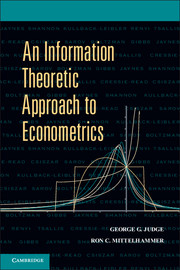Book contents
- Frontmatter
- Contents
- Preface
- One Econometric Information Recovery
- Part I Traditional Parametric and Semiparametric Econometric Models: Estimation and Inference
- Two Formulation and Analysis of Parametric and Semiparametric Linear Models
- Three Method of Moments, Generalized Method of Moments, and Estimating Equations
- Part II Formulation and Solution of Stochastic Inverse Problems
- Part III A Family of Minimum Discrepancy Estimators
- Part IV Binary–Discrete Choice Minimum Power Divergence (MPD) Measures
- Part V Optimal Convex Divergence
- Abbreviations
- Index
- References
Three - Method of Moments, Generalized Method of Moments, and Estimating Equations
from Part I - Traditional Parametric and Semiparametric Econometric Models: Estimation and Inference
Published online by Cambridge University Press: 05 June 2012
- Frontmatter
- Contents
- Preface
- One Econometric Information Recovery
- Part I Traditional Parametric and Semiparametric Econometric Models: Estimation and Inference
- Two Formulation and Analysis of Parametric and Semiparametric Linear Models
- Three Method of Moments, Generalized Method of Moments, and Estimating Equations
- Part II Formulation and Solution of Stochastic Inverse Problems
- Part III A Family of Minimum Discrepancy Estimators
- Part IV Binary–Discrete Choice Minimum Power Divergence (MPD) Measures
- Part V Optimal Convex Divergence
- Abbreviations
- Index
- References
Summary
Introduction
In the previous chapter, we generalized the linear model to include stochastic regressors and examined the corresponding statistical implications. In this chapter, we examine estimation and inference methods for obtaining information on parameters that are functionally related to moments of the sampling distribution underlying a sample of data. The approach can be categorized on the basis of the number of functionally independent moment equations relative to the number of parameters being analyzed and the extent to which the set of moment equations can be solved simultaneously to yield values of the parameters. One possible outcome is the case that the parameters are underdetermined by the system of moment equations, meaning that there is insufficient information in the system to solve for the parameters uniquely. Another possible outcome is that the parameters can be just-determined by the system of moment equations, in which case there is just enough information in the system for there to be a unique solution for the parameters. Finally, the parameters may be overdetermined, in which case there is an overabundance of information in the system of moment equations such that there is no value of the parameters that can solve all of the moment equations in the system simultaneously. The case in which a unique solution exists subsumes the classical Pearson's method of moments (MOM), also referred to as the ordinary method of moments, and the overdetermined case relates to the generalized method of moments (GMM). We focus on the just-determined and overdetermined cases in this chapter and examine both the MOM and the GMM approaches to estimation and inference. The case in which the set of moments underdetermines the parameters is a major focus of this book and is addressed in later chapters.
We also introduce the concept of estimating equations (EEs), which subsumes the moment equation approaches, and also subsumes the least squares (LS), maximum likelihood (ML), and extremum (E) estimation methods of estimation and inference when estimates are characterized by first-order conditions. In this context, the EE approach is a unifying estimation and inference paradigm for defining estimators and estimates for unknowns in an econometric model. We also note how the E estimation approach for obtaining information on the unknowns of an econometric model, introduced in Section 2.5, relates to the methods examined in this chapter.
- Type
- Chapter
- Information
- An Information Theoretic Approach to Econometrics , pp. 36 - 66Publisher: Cambridge University PressPrint publication year: 2011



